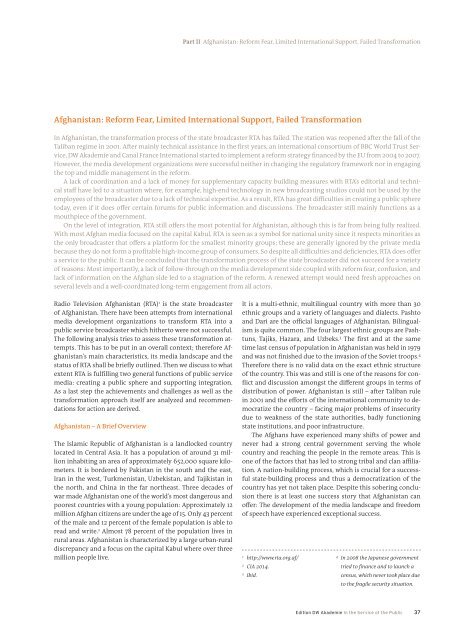edition-dw-akademie-in-the-service-of-the-public-functions-and-transformation-of-media-in-developing-countries-pdf
edition-dw-akademie-in-the-service-of-the-public-functions-and-transformation-of-media-in-developing-countries-pdf
edition-dw-akademie-in-the-service-of-the-public-functions-and-transformation-of-media-in-developing-countries-pdf
You also want an ePaper? Increase the reach of your titles
YUMPU automatically turns print PDFs into web optimized ePapers that Google loves.
Part II Afghanistan: Reform Fear, Limited International Support, Failed TransformationAfghanistan: Reform Fear, Limited International Support, Failed TransformationIn Afghanistan, <strong>the</strong> <strong>transformation</strong> process <strong>of</strong> <strong>the</strong> state broadcaster RTA has failed. The station was reopened after <strong>the</strong> fall <strong>of</strong> <strong>the</strong>Taliban regime <strong>in</strong> 2001. After ma<strong>in</strong>ly technical assistance <strong>in</strong> <strong>the</strong> first years, an <strong>in</strong>ternational consortium <strong>of</strong> BBC World Trust Service,DW Akademie <strong>and</strong> Canal France International started to implement a reform strategy f<strong>in</strong>anced by <strong>the</strong> EU from 2004 to 2007.However, <strong>the</strong> <strong>media</strong> development organizations were successful nei<strong>the</strong>r <strong>in</strong> chang<strong>in</strong>g <strong>the</strong> regulatory framework nor <strong>in</strong> engag<strong>in</strong>g<strong>the</strong> top <strong>and</strong> middle management <strong>in</strong> <strong>the</strong> reform.A lack <strong>of</strong> coord<strong>in</strong>ation <strong>and</strong> a lack <strong>of</strong> money for supplementary capacity build<strong>in</strong>g measures with RTA’s editorial <strong>and</strong> technicalstaff have led to a situation where, for example, high-end technology <strong>in</strong> new broadcast<strong>in</strong>g studios could not be used by <strong>the</strong>employees <strong>of</strong> <strong>the</strong> broadcaster due to a lack <strong>of</strong> technical expertise. As a result, RTA has great difficulties <strong>in</strong> creat<strong>in</strong>g a <strong>public</strong> spheretoday, even if it does <strong>of</strong>fer certa<strong>in</strong> forums for <strong>public</strong> <strong>in</strong>formation <strong>and</strong> discussions. The broadcaster still ma<strong>in</strong>ly <strong>functions</strong> as amouthpiece <strong>of</strong> <strong>the</strong> government.On <strong>the</strong> level <strong>of</strong> <strong>in</strong>tegration, RTA still <strong>of</strong>fers <strong>the</strong> most potential for Afghanistan, although this is far from be<strong>in</strong>g fully realized.With most Afghan <strong>media</strong> focused on <strong>the</strong> capital Kabul, RTA is seen as a symbol for national unity s<strong>in</strong>ce it respects m<strong>in</strong>orities as<strong>the</strong> only broadcaster that <strong>of</strong>fers a platform for <strong>the</strong> smallest m<strong>in</strong>ority groups; <strong>the</strong>se are generally ignored by <strong>the</strong> private <strong>media</strong>because <strong>the</strong>y do not form a pr<strong>of</strong>itable high-<strong>in</strong>come group <strong>of</strong> consumers. So despite all difficulties <strong>and</strong> deficiencies, RTA does <strong>of</strong>fera <strong>service</strong> to <strong>the</strong> <strong>public</strong>. It can be concluded that <strong>the</strong> <strong>transformation</strong> process <strong>of</strong> <strong>the</strong> state broadcaster did not succeed for a variety<strong>of</strong> reasons: Most importantly, a lack <strong>of</strong> follow-through on <strong>the</strong> <strong>media</strong> development side coupled with reform fear, confusion, <strong>and</strong>lack <strong>of</strong> <strong>in</strong>formation on <strong>the</strong> Afghan side led to a stagnation <strong>of</strong> <strong>the</strong> reform. A renewed attempt would need fresh approaches onseveral levels <strong>and</strong> a well-coord<strong>in</strong>ated long-term engagement from all actors.Radio Television Afghanistan (RTA) 1 is <strong>the</strong> state broadcaster<strong>of</strong> Afghanistan. There have been attempts from <strong>in</strong>ternational<strong>media</strong> development organizations to transform RTA <strong>in</strong>to a<strong>public</strong> <strong>service</strong> broadcaster which hi<strong>the</strong>rto were not successful.The follow<strong>in</strong>g analysis tries to assess <strong>the</strong>se <strong>transformation</strong> attempts.This has to be put <strong>in</strong> an overall context; <strong>the</strong>refore Afghanistan’sma<strong>in</strong> characteristics, its <strong>media</strong> l<strong>and</strong>scape <strong>and</strong> <strong>the</strong>status <strong>of</strong> RTA shall be briefly outl<strong>in</strong>ed. Then we discuss to whatextent RTA is fulfill<strong>in</strong>g two general <strong>functions</strong> <strong>of</strong> <strong>public</strong> <strong>service</strong><strong>media</strong>: creat<strong>in</strong>g a <strong>public</strong> sphere <strong>and</strong> support<strong>in</strong>g <strong>in</strong>tegration.As a last step <strong>the</strong> achievements <strong>and</strong> challenges as well as <strong>the</strong><strong>transformation</strong> approach itself are analyzed <strong>and</strong> recommendationsfor action are derived.Afghanistan – A Brief OverviewThe Islamic Re<strong>public</strong> <strong>of</strong> Afghanistan is a l<strong>and</strong>locked countrylocated <strong>in</strong> Central Asia. It has a population <strong>of</strong> around 31 million<strong>in</strong>habit<strong>in</strong>g an area <strong>of</strong> approximately 652,000 square kilometers.It is bordered by Pakistan <strong>in</strong> <strong>the</strong> south <strong>and</strong> <strong>the</strong> east,Iran <strong>in</strong> <strong>the</strong> west, Turkmenistan, Uzbekistan, <strong>and</strong> Tajikistan <strong>in</strong><strong>the</strong> north, <strong>and</strong> Ch<strong>in</strong>a <strong>in</strong> <strong>the</strong> far nor<strong>the</strong>ast. Three decades <strong>of</strong>war made Afghanistan one <strong>of</strong> <strong>the</strong> world’s most dangerous <strong>and</strong>poorest <strong>countries</strong> with a young population: Approximately 12million Afghan citizens are under <strong>the</strong> age <strong>of</strong> 15. Only 43 percent<strong>of</strong> <strong>the</strong> male <strong>and</strong> 12 percent <strong>of</strong> <strong>the</strong> female population is able toread <strong>and</strong> write. 2 Almost 78 percent <strong>of</strong> <strong>the</strong> population lives <strong>in</strong>rural areas. Afghanistan is characterized by a large urban-ruraldiscrepancy <strong>and</strong> a focus on <strong>the</strong> capital Kabul where over threemillion people live.1http://www.rta.org.af/It is a multi-ethnic, multil<strong>in</strong>gual country with more than 30ethnic groups <strong>and</strong> a variety <strong>of</strong> languages <strong>and</strong> dialects. Pashto<strong>and</strong> Dari are <strong>the</strong> <strong>of</strong>ficial languages <strong>of</strong> Afghanistan. Bil<strong>in</strong>gualismis quite common. The four largest ethnic groups are Pashtuns,Tajiks, Hazara, <strong>and</strong> Uzbeks. 3 The first <strong>and</strong> at <strong>the</strong> sametime last census <strong>of</strong> population <strong>in</strong> Afghanistan was held <strong>in</strong> 1979<strong>and</strong> was not f<strong>in</strong>ished due to <strong>the</strong> <strong>in</strong>vasion <strong>of</strong> <strong>the</strong> Soviet troops. 4Therefore <strong>the</strong>re is no valid data on <strong>the</strong> exact ethnic structure<strong>of</strong> <strong>the</strong> country. This was <strong>and</strong> still is one <strong>of</strong> <strong>the</strong> reasons for conflict<strong>and</strong> discussion amongst <strong>the</strong> different groups <strong>in</strong> terms <strong>of</strong>distribution <strong>of</strong> power. Afghanistan is still – after Taliban rule<strong>in</strong> 2001 <strong>and</strong> <strong>the</strong> efforts <strong>of</strong> <strong>the</strong> <strong>in</strong>ternational community to democratize<strong>the</strong> country – fac<strong>in</strong>g major problems <strong>of</strong> <strong>in</strong>securitydue to weakness <strong>of</strong> <strong>the</strong> state authorities, badly function<strong>in</strong>gstate <strong>in</strong>stitutions, <strong>and</strong> poor <strong>in</strong>frastructure.The Afghans have experienced many shifts <strong>of</strong> power <strong>and</strong>never had a strong central government serv<strong>in</strong>g <strong>the</strong> wholecountry <strong>and</strong> reach<strong>in</strong>g <strong>the</strong> people <strong>in</strong> <strong>the</strong> remote areas. This isone <strong>of</strong> <strong>the</strong> factors that has led to strong tribal <strong>and</strong> clan affiliation.A nation-build<strong>in</strong>g process, which is crucial for a successfulstate-build<strong>in</strong>g process <strong>and</strong> thus a democratization <strong>of</strong> <strong>the</strong>country has yet not taken place. Despite this sober<strong>in</strong>g conclusion<strong>the</strong>re is at least one success story that Afghanistan can<strong>of</strong>fer: The development <strong>of</strong> <strong>the</strong> <strong>media</strong> l<strong>and</strong>scape <strong>and</strong> freedom<strong>of</strong> speech have experienced exceptional success.2CIA 2014.3Ibid.4In 2008 <strong>the</strong> Japanese governmenttried to f<strong>in</strong>ance <strong>and</strong> to launch acensus, which never took place dueto <strong>the</strong> fragile security situation.Edition DW Akademie In <strong>the</strong> Service <strong>of</strong> <strong>the</strong> Public 37


